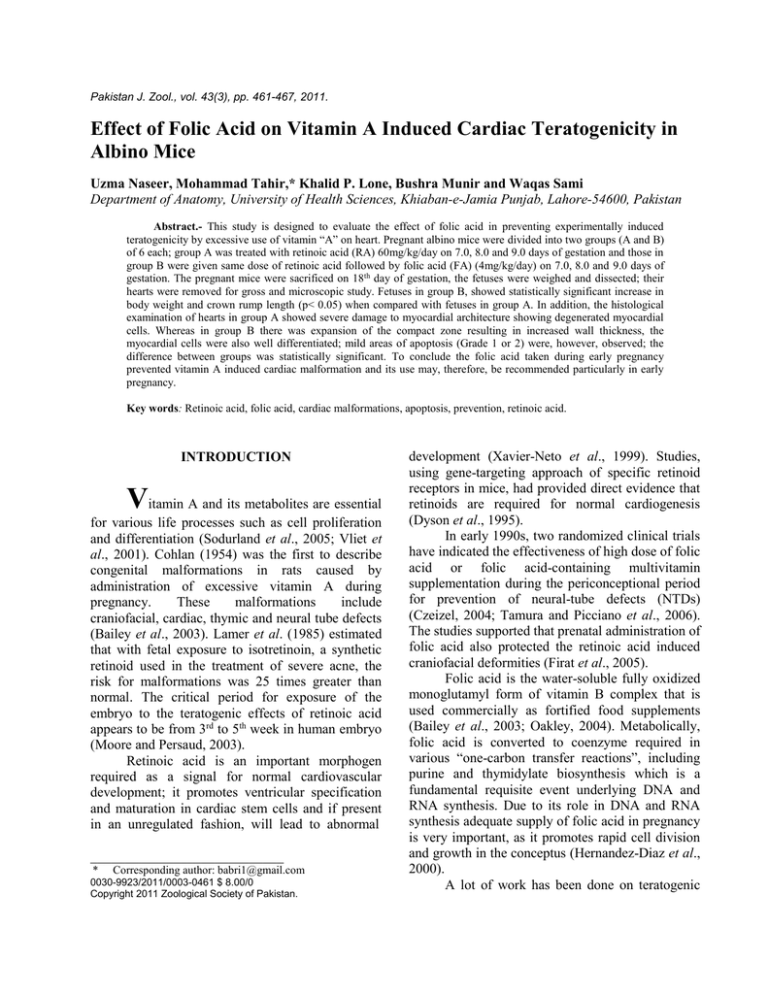38
advertisement

Pakistan J. Zool., vol. 43(3), pp. 461-467, 2011. Effect of Folic Acid on Vitamin A Induced Cardiac Teratogenicity in Albino Mice Uzma Naseer, Mohammad Tahir,* Khalid P. Lone, Bushra Munir and Waqas Sami Department of Anatomy, University of Health Sciences, Khiaban-e-Jamia Punjab, Lahore-54600, Pakistan Abstract.- This study is designed to evaluate the effect of folic acid in preventing experimentally induced teratogenicity by excessive use of vitamin “A” on heart. Pregnant albino mice were divided into two groups (A and B) of 6 each; group A was treated with retinoic acid (RA) 60mg/kg/day on 7.0, 8.0 and 9.0 days of gestation and those in group B were given same dose of retinoic acid followed by folic acid (FA) (4mg/kg/day) on 7.0, 8.0 and 9.0 days of gestation. The pregnant mice were sacrificed on 18th day of gestation, the fetuses were weighed and dissected; their hearts were removed for gross and microscopic study. Fetuses in group B, showed statistically significant increase in body weight and crown rump length (p< 0.05) when compared with fetuses in group A. In addition, the histological examination of hearts in group A showed severe damage to myocardial architecture showing degenerated myocardial cells. Whereas in group B there was expansion of the compact zone resulting in increased wall thickness, the myocardial cells were also well differentiated; mild areas of apoptosis (Grade 1 or 2) were, however, observed; the difference between groups was statistically significant. To conclude the folic acid taken during early pregnancy prevented vitamin A induced cardiac malformation and its use may, therefore, be recommended particularly in early pregnancy. Key words: Retinoic acid, folic acid, cardiac malformations, apoptosis, prevention, retinoic acid. INTRODUCTION Vitamin A and its metabolites are essential for various life processes such as cell proliferation and differentiation (Sodurland et al., 2005; Vliet et al., 2001). Cohlan (1954) was the first to describe congenital malformations in rats caused by administration of excessive vitamin A during pregnancy. These malformations include craniofacial, cardiac, thymic and neural tube defects (Bailey et al., 2003). Lamer et al. (1985) estimated that with fetal exposure to isotretinoin, a synthetic retinoid used in the treatment of severe acne, the risk for malformations was 25 times greater than normal. The critical period for exposure of the embryo to the teratogenic effects of retinoic acid appears to be from 3rd to 5th week in human embryo (Moore and Persaud, 2003). Retinoic acid is an important morphogen required as a signal for normal cardiovascular development; it promotes ventricular specification and maturation in cardiac stem cells and if present in an unregulated fashion, will lead to abnormal ____________________________ * Corresponding author: babri1@gmail.com 0030-9923/2011/0003-0461 $ 8.00/0 Copyright 2011 Zoological Society of Pakistan. development (Xavier-Neto et al., 1999). Studies, using gene-targeting approach of specific retinoid receptors in mice, had provided direct evidence that retinoids are required for normal cardiogenesis (Dyson et al., 1995). In early 1990s, two randomized clinical trials have indicated the effectiveness of high dose of folic acid or folic acid-containing multivitamin supplementation during the periconceptional period for prevention of neural-tube defects (NTDs) (Czeizel, 2004; Tamura and Picciano et al., 2006). The studies supported that prenatal administration of folic acid also protected the retinoic acid induced craniofacial deformities (Firat et al., 2005). Folic acid is the water-soluble fully oxidized monoglutamyl form of vitamin B complex that is used commercially as fortified food supplements (Bailey et al., 2003; Oakley, 2004). Metabolically, folic acid is converted to coenzyme required in various “one-carbon transfer reactions”, including purine and thymidylate biosynthesis which is a fundamental requisite event underlying DNA and RNA synthesis. Due to its role in DNA and RNA synthesis adequate supply of folic acid in pregnancy is very important, as it promotes rapid cell division and growth in the conceptus (Hernandez-Diaz et al., 2000). A lot of work has been done on teratogenic 462 U. NASEER ET AL. effects of retinoic acid on heart, nervous system and other organs of the body; there is also evidence that use of folic acid by pregnant women reduces the risk of having an infant with neural-tube defects. However, it is not clear whether folic acid or some other component in the multivitamins is responsible for reducing the risk, since most multivitamins contain more than 15 vitamins and minerals (Hernandez-Diaz et al., 2000). There is, however, hardly any work on the role of folic acid in preventing vitamin A induced cardiac anomalies. It was, therefore, contemplated to study this aspect, hoping that use of folic acid during early pregnancy may reduce cardiac abnormalities. MATERIALS ANS METHODS National Institute of Health, Islamabad was approached to provide sixteen albino mice (Twelve females and four males) 6-8 weeks old, weighing 25-30 gm. The animals were kept in Experimental Research Laboratory of University of Health Sciences, Lahore under controlled conditions of light and dark cycles of 12 hours each, temperature, (22±0.5ºC), humidity (50 ± 10%). All the animals were examined thoroughly and weighed before the commencement of the experiment to include only healthy animals in the experiment. They were fed on mouse chow and water ad libitum. The experimental animals were randomly divided into two groups, each containing eight animals, six female and two males. Male and female mice were placed together (1:3) overnight for mating, the pregnancy was confirmed by the presence of vaginal plug when examined on the following morning; this was denoted as gestational day 0 (zero) (Wolf, 1996, Mehrotra and Shah, 2004). Animals of group A were given 60mg/kg/day of retinoic acid dissolved in 0.1ml of olive oil orally on 7th, 8th and 9th day of pregnancy. In group B, retinoic acid (60mg/kg/day) dissolved in 0.1 ml of olive oil and folic acid (4mg/kg/day) dissolved in 0.1 ml of distilled water was given orally on comparable days of pregnancy. Pregnant mice were sacrificed and dissected on the 18th day of gestation to obtain the fetuses. The fetuses were dissected using stereo microscope and their hearts were removed for histological preparation; these were fixed in 10% formalin for 48 hours and later processed for preparation of paraffin blocks. Longitudinal sections of heart, 5µ thick, were obtained using Leica rotatory microtome (RM 2125); the sections were stained with Haematoxylin and Eosin for examination with the light microscope (Leica DM 1000). Micrometry The size of the heart, left and right ventricular wall thickness were separately calculated by randomly selecting 6 different places in the sections, using ocular and stage linear micrometer (Oakley, 2004). A semi-quantitative scale was used for histopathological comparisons within the experimental tissues. Myocyte apoptosis was an index of cell death in tissue sections and was graded as follows: 0, apoptosis not present; +1, mild, comprising a single small focus of apoptosis; +2, moderate, multifocal-to-confluent foci; and +3, severe, large confluent clusters and/or transmural involvement (Fatkin et al., 1991). Statistical analysis The statistical analysis was carried out using computer software Statistical package for social sciences (SPSS) version 16. The arithmetic mean, standard error of mean and the significance between two groups was calculated by independent t test and chi-square test using in SPSS. The difference was regarded statistically significant if the ‘p’ value was < 0.05. RESULTS Litter size The litter size was 41 in group A and 45 in group B. There were 11 dead and 30 alive fetuses whereas there were 5 dead and 40 alive fetuses in groups A and B respectively. On comparison, the difference between the dead and alive fetuses was insignificant between groups whereas it was found to be significant when normal and abnormal fetuses were compared between the groups (Table I). There was an increase in the crown rump length (CRL) and weight of fetuses in group B and the difference VITAMIN A INDUCED CARDIAC TERATOGENICITY between the groups was also found to be statistically significant using independent T test (Table II). Table I.- Comparison of pregnancy outcome in groups A and B. Parameter Group A (n=41) Group B (n=45) p-value Dead fetuses Abnormal fetuses Interventricular septal defects Valve malformations 11(12.8%) 10(11.6%) 9(10.5%) 5(7%) 2(2.3%) 5(5.8%) 0.116† 0.011*†† 0.174† 9(21.95%) 4(8.8%) 0.088†† of process of compaction. The difference in the thickness of ventricular wall in group B compared to the group A was statistically significant (p<0.05). In group B, thick compact myocardium (Fig. 3) was observed. Figure in parenthesis indicate total number of fetuses and their %ages in each group. * p<0.05 statistically significant † Statistical analysis by Pearson chi square test †† statistical analysis by Fisher exact test Table II.- Comparison of various parameters of fetuses from groups A and B using Independent sample T test. Parameter Group A Group B pvalue CRL(cm) Weight of fetuses (g) Heart weight(mg) Heart size (µm) Lt. ventricular wall thickness (µm) 2.3±0.04 1.3±0.02 12.7±0.2 1899±80 274±10 2.5±0.03 1.49±0.01 11.8±0.1 1702±26 328.7±10 0.000* 0.000* 0.001* 0.018* 0.000* Fig. 1. Photograph of grossly malformed fetus with its placenta (red arrow) in group A; cephalic end (yellow arrow) and caudal end (blue arrow) could be recognized; limbs are not formed and the fetus appears to show growth retardation on 18 gestational day. *p<0.05 statistically significant. Gross appearance Heart appeared globular in group A and was situated on the left side in all fetuses. In group B the shape of the heart was ellipsoid and comparable to the shape of the normal heart. The increase in the weight of the organ in group A compared with the group B was found to be statistically significant using independent T test (p<0.05; Table II). Histological features The increase in the size of the ventricles in group A compared with that in group B, was statistically significant (p<0.05; Table II). Myocardium in fetal hearts from group A, showed myofibril disarray (Fig. 2) with marked decrease in wall thickness of both ventricles when compared with the group B (Table II). In group A, the myocardium was thin apparently on account of loss 463 Fig. 2. Photomicrograph of fetal heart from group A: Ventricle shows epicardium (blue arrow) covered with low cuboidal mesothelium. Cardiac muscle cells show pyknotic nuclei (yellow arrow), branching pattern is not discernable and the myocardium lacks compaction. H and E stain X 200. 464 U. NASEER ET AL. Fig. 3. Photomicrograph of fetal heart from group B: showing cardiac muscle cells having oval, centrally located nuclei (green arrow) and slightly attenuated cytoplasm; muscle fasciculi show usual branching pattern (black arrow); small sized capillaries containing RBCs are seen at places; one longitudinal section of a vessel is also seen and appears to be an arteriole in nature (Blue arrow). H and E stain X 400. Fig. 5. (I); Photomicrograph of fetal heart from group A, showing epicardium with mesothelial cells (blue arrow) and endocardium (red arrow), atrial wall shows significant thinning due to non development or degeneration of cardiomyocytes. (II); Photomicrograph of fetal heart from group B: Atrium showing myocardium with well differentiated myocardial cells in transverse sectional profile (blue arrow) and epicardium (green arrow) and endocardium (red arrow). H and E stain X 400. The myocardium in group A, showed multifocal myocardial apoptosis in various stages; the nuclei showed dense chromatin indicative of pyknosis; in other myocardial fibers they were crescentic in shape and fragmented (Fig. 2). In group B, the myocardium showed mixed pattern i.e., muscle fibers with regular branching and well formed nuclei and at other foci there was myofibrillar disarray with mild to moderate apoptosis in myocardial fibers and their nuclei (Fig. 3; Table III). The endocardium remained unchanged in both the treated groups. Table III.Fig. 4. Photomicrograph of fetal heart from group B; ventricular septal defect is seen in membranous part of the septum, where as the muscular part (IVS) is well formed. The blood is seen flowing from one ventricular cavity to the other (red arrow) at septal defect. The fused leaflets of aortic valve (black arrow) and detached epicardium (yellow arrow) are also seen. H and E stain X40. Comparison of occurrence of apoptosis in myocardium of groups A and B. Groups Mild Moderate Severe Total Group A 0(0%) 8(9.3%) 33(38.4%) 41(47.7%) Group B 16(18.6%) 26(30.2%) 3(3.5%) 45(52.3%) Total 16(18.6%) 34(39.5%) 36(41.9%) 86(100%) *p<0.05 statistically significant VITAMIN A INDUCED CARDIAC TERATOGENICITY Septum Malformations of inter ventricular septum were observed in 9 out of 41 (10.5%) fetuses of group A which were more pronounced in the upper part of the septum. In group B, 5 out of 45 (5.8%) fetuses also showed ventricular septal defect (VSD) (Fig. 4) situated in its membranous part similar to that found in group A. The comparison of incidence of VSD between groups A and B was statistically insignificant (p>0.05, Table I). Atria Fetal heart from group A showed thinning of atrial wall with few cardiomyocytes in it (Fig. 5.I). In group B, atrial wall showed multiple layers of myocardial cells which were well differentiated (Fig. 5.II). Valves The Atrio-ventricular (AV) valves of fetal heart from group A showed various malformations like, thinning and fusion of the leaflets. In group B, 4 out of 45 fetuses showed fused leaflets and other malformations which were statistically insignificant when compared between the groups (Fig.4, Table I). DISCUSSION Congenital anomalies are one of leading causes of infant mortality and childhood morbidity, affecting 2-3% of all newborns (WHO, 2001). Each year nearly 3% of newly born infants in the world are affected with major congenital abnormalities (Czeizel, 2004). In the United States, the number of deaths attributed to heart defects alone is estimated to be 6000/year and account for one-tenth of infant deaths (Wolf, 1996). Retinoids act at distinct developmental stages; it controls situs determination, heart looping and chamber determination (Dolk et al., 1999). Administration of excess retinoic acid during early pregnancy has striking teratogenic effects on heart development (Niederreither et al., 2001). Our observation showed that retinoic acid treatment with 60mg/kg resulted in decreased body weights, CRL and an increased mortality of the conceptuses as reported by Firat et al. (2005) and Nobakht et al. (2006). We also observed a severe growth retardation with gross malformations in the 465 fetuses of group A as compared to fetuses of group B (p<0.05); the findings are also in accord with those of Huang et al. (2001). Further, our observations on group B also showed an increase in mean body weight and CRL of the fetuses (p<0.05); the difference in mortality rate between the groups was, however, not statistically significance. This presumably indicated that FA prevented congenital abnormalities induced by RA to a considerable extent but did not reduce the mortality rate. Micrometry of fetal hearts on histological sections of group A showed; thinning of myocardium due to failure in expansion of the compact zone. Our findings were consistent with previous studies in which “Retinoid X receptor α gene knockout mice” showed apoptosis in the myocardium with failure in the process of compaction (Merki et al., 2005; Gruber et al., 1996). Myocardium of fetal heart of group A showed pyknotic and fragmented nuclei (Fig.2); this could possibly be explained on basis of teratogenic effects of retinoids and their ability to induce apoptosis. This observation was further supported by a study in which pregnant mice treated with a teratogenic dose of Retinoic acid (100 mg/kg) on 11 days postcoitum (dpc) resulted in apoptosis in the central mesenchymal core of the limb bud involved in chondrogenesis (Kochhar, 2004). Excessive vitamin A or its derivatives are reported to have affected normal cardiac mesodermal development, and also produced defects in cardiac neural crest derivatives (Niederreither et al., 2001). Neural crest cells are necessary for normal differentiation of myocardium, septation of heart (Kirby and Waldo, 1995) and development of cardiac valves (Waldo et al., 1999). Our observations support the earlier work, as fetuses in group A during our investigations showed malformations of upper part of inter-ventricular septum (future membranous part) and damage to the myocardial architecture. It is likely that VSDs present in these fetuses are responsible for increased mortality. In our study atrioventricular valves showed thinning of leaflets in group A which was presumably due to apoptosis of cells; however, there 466 U. NASEER ET AL. was no change in the endocardium. These findings were further supported by an earlier study in which diminished growth of atrio-ventricular cushions was found in retinoic acid treated chicken embryos (Bouman et al., 1998). This could be explained on the basis of increased susceptibility of neural crest cells to apoptosis under influence of higher retinoid concentrations (Poelmann et al., 2000: Poelmann and Gittenberger-De Groot, 2005: Keyes and Sanders, 2002). There is strong evidence supporting the conclusion that peri-conceptional multivitamins containing folic acid may reduce the risk of congenital heart defects (Tamura and Picciano, 2006), Folic acid antagonists increased the risk of certain birth defects like cardiovascular defects, oral cleft and urinary tract defects when given in early pregnancy, thus supporting the hypothesis that folic acid prevents these defects (Hernandez-Diaz et al., 2000). The histological sections of heart from group B exhibited simple defect in the developing myocardium, showing nearly differentiated cells and mild to moderate degree of apoptosis. The membranous part of the interventricular septum, embryologically a neural crest cell derivative, was also affected in both treated groups (A and B), the difference was statistically insignificant (p>0.05). These finding were in accord with the findings of Werler et al. (1999), who detected no association between prevention of congenital heart defects i.e. ventricular septal defect and out flow tract and periconceptional use of multivitamins in a hospital based case control study (Werler et al., 1999). It had been reported that trans-retinoic acidinduced apoptosis in the mesenchymal cells of the mouse developing palate was mediated through activation of caspases and was dependent on retinoic acid receptor (RAR) pathways (Keyes and Sanders, 2002). The Caspases also activated other degradative enzymes such as DNAses, which began to cleave the DNA in the nucleus leading to apoptosis (Zengli et al., 2006). On the other hand folic acid is also indirectly a methyl donor in many methylation reactions thus acting as a gene regulator preventing apoptosis induced by vitamin A. CONCLUSIONS Our findings indicate preventive effect of Folic acid on vitamin A induced cardiac abnormalities to some extent if given during the period of organogenesis; we presume that the effects are dependent on the basic mechanism of action of folic acid, which functions as cofactor in series of interconnected metabolic cycles, involving thymidilate and purine biosynthesis (DNA) and is essential for cell division and differentiation (Tamura and Picciano, 2006; Van der Put et al., 2001). ACKNOWLEDGEMENTS We are grateful to Professor Dr. Malik Hussain Mubbashar, Vice Chancellor of University of Health Sciences for his continuous encouragement and providing funding support to complete my research project. UN is also grateful to her husband for his help in looking after the children during the course of this work. REFERENCES BAILEY, L.B., RAMPERSAUD, G.C. AND KAUWELL, G.P.A., 2003. Folic acid supplements and fortification affect the risk for neural tube defects, vascular disease and cancer: evolving science. J. Nutr., 133: 1961S-68S. BOUMAN, H.G.A., BROEKUIZN, M.L.A., BAASTEN, A.M.J., GROOT, A.C.G. AND WENINK, A.C.G., 1998. Diminished growth of atrioventricular cushion tissue in stage 24 retinoic acid treated chicken embryos. Dev. Dyn., 213:50-58. COHLAN, S.Q., 1954. Congenital anomalies in the rat produced by excessive intake of vitamin A during pregnancy. Pediatrics, 13: 556-567. CZEIZEL, A.E., 2004. The primary prevention of birth defects: Multivitamins or folic acid? Int. J. Med. Sci., 1:50-61. DOLK, H.M., NAU, H., HUMMLER, H. AND BARLOW, S.M., 1999. Dietary vitamin A and teratogenic risk: European Teratology Society discussion paper. Eur. J. Obstet. Gynaecol. Reprod. Biol., 83: 31-36. DYSON, E., SUCOV, H.M., KUBALAK, S.W., SCHONBEIN, A.G., DELANO, F.A. AND EVANS, R.M., 1995. Atrial-like phenotype is associated with embryonic ventricular failure in retinoid X receptor α -/- mice. Proc. natl. Acad. Sci., 92:7386-7390. FATKIN, D., CHRISTE, M.E. AND ARISTIZABAL, O., 1991. Neonatal cardiomyopathy in mice homozygous for the VITAMIN A INDUCED CARDIAC TERATOGENICITY Arg403Gln mutation in α cardiac myosin heavy chain gene. J. Clin. Invest., 103: 147-153. FIRAT, D., KUNTSAL, L. AND SIRIN, Y., 2005. Protective effects of prenatal administration of folic acid induced cellular damages of Meckel’s cartilage in rats. Tohoku J. exp. Med., 205: 27-36. GRUBER, P.J., KUBALAK, S.W., PEXIEDER, T., SUCOV, S.M., EVANS, R.M. AND CHIEN, K.R., 1996. RXRα deficiency confers genetic susceptibility for aortic sac, conotruncal, atrioventricular cushion and ventricular muscle defects in mice. J. Clin. Invest., 98: 1332-1343. HERNANDEZ-DIAZ, S., WERLER, M.M., WALKER, A.M. AND MITCHEL, A.A., 2000. Folic acid antagonist during pregnancy and the risk of birth defects. New Engl. J. Med., 343: 1608-1614. HUANG, F.J., WU, T.C.J. AND TSAI, M.Y., 2001. Effect of retinoic acid on implantation and post- implantation development of mouse embryo in vitro. Human Reprod., 16: 2171-2176. KEYES, W.M. AND SANDERS, E.J., 2002. Regulation of apoptosis in the endocardial cushion of the developing chick heart. Am. J. Physiol. Cell Physiol., 282: C1348C1360. KIRBY, M.L. AND WALDO, K.L., 1995. Neural crest and cardiovascular patterning. Circul. Res., 77: 211-215. KOCHHAR, Z.J., 2004. Cellular anomalies underlying retinoidinduced phocomelia. Reprod. Toxicol., 19: 103-110. MEHROTRA, N. AND SHAH, G.L., 2004. Effect of prenatal vitamin A in low doses on the liver and kidney of rat fetuses- A histological study. J. Anat. Soc. India, 53: 25-28. MERKI, E., ZAMORA, M., RAYA, A., KAWAKAMI, Y., WANG, J. AND ZHANG, X., 2005 Epicardial retinoid X receptor α is required for myocardial growth and coronary artery formation. Proc. natl. Acad. Sci., 102: 18455-18460. MOORE, K.L. AND PERSAUD, T.V.N., 2003. The developing human clinically oriented embryology. 7th ed. Philadelphia: Elsevier. NIEDERREITHER, K, VERMOT, J., MESSADDEQ, N., SCHUHBAUR, B.M CHAMBON, P. AND DOLLE, P., 2001. Embryonic retinoic acid synthesis is essential for heart morphogenesis in the mouse. Development, 128: 1019-1031. NOBAKHT, M., ZIRAK, A., MEHDIZADEH, M. AND TABATABAEEI, P., 2006. Teratogenic effects of retinoic acid on neurulation in mice embryos. Pathphysiology, 13: 57-61. OAKLEY, G.P., 2004. Oral synthetic folic acid and vitamin B12 supplements work- if one consumes them. Nutr. Rev., 62: S22-S26. 467 POELMANN, R.E., MOLIN, D., WISSE, L.J., AND GITTENBERGER-DE GROOT, A.C., 2000 Apoptosis in cardiac development. Cell Tiss. Res., 301 :43-52. POELMANN, R.E. AND GITTENBERGER-DE GROOT, A.C., 2005. Apoptosis as an instrument in cardiovascular development. Birth Defects Res. C Embryo Today, 75: 305-313. ROTHMAN, K.J., MOORE, L.L. AND SINGER, M.R., 1995. Teratogenicity of high vitamin A intake. New Engl. J. Med., 333: 369-373. SODERLUND, M.B., FEX, G.A. AND NILSSON-EHLE, P., 2005. Concentrations of retinoids in early pregnancy and in newborns and their mothers. Am. J. Clin. Nutr., 81:633-636. TAMURA, T. AND PICCIANO, M.F., 2006. Folate and human reproduction. Am. J. Clin. Nutr., 83: 993-1016. VANDER PUT, N.M.J., STRAATEN, H.W.M., TRIJBELS, F.J.M. AND BLOM, H.J., 2001. Folate, homocysteine and neural tube defects: An overview. Exp. Biol. Med., 226: 243-270. VLIET, T.V., BOELSMA, E., VRIES, A.J. AND BERG, H.V., 2001.Retinoic acid metabolites in plasma are higher after intake of liver paste compared with a vitamin A supplement in women: J. Nutr., 131: 3197-3203. WALDO, K., ZDANOWICZ, M., BURCH, J., KUMISKI, D.H., STADT, H.A. AND GODT, R.E., 1999. A novel role for cardiac neural crest in heart development. J. Clin. Invest., 103: 1499-1507. WERLER, M.M., HAYES, C. AND LOUIK, C., 1999. Multivitamin supplementation and risk of birth defects. Am. J. Epidemiol., 150:675-682. WOLF, G., 1996. A history of vitamin A and retinoids. FASEB J., 10: 1102-07. WORLD HEALTH ORGANIZATION, 2001. Report of WHO registry meeting on craniofacial deformities. In: Global Registry and database on craniofacial anomalies (eds. P. Mosey and E. Castilla) WHO registry meeting on craniofacial anomalies, Baru, Brazil, pp. 26. XAVIER-NETO, J., NEVILLE, C.M., SHAPIRO, M.D., HOUGHTON, L., WANG, G.F. AND NIKOVITS, Jr, W., 1999. A retinoic acid inducible transgenic maker of sinoatrial development in the heart mouse. Development, 126: 2677-2687. ZENGLI, Y.U., JING, H.A.N., LIN, J., XIAO, Y. ZHANG, X. AND YONG, L., 2006. Apoptosis induced by atRA in MEPM cells is mediated through activation of caspases and RAR. Toxicol. Sci., 89: 504-509. (Received 17 June 2010, revised 31 August 2010)



